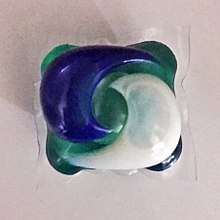Laundry detergent pod

Laundry detergent pods (or packs) are water-soluble pouches containing highly concentrated laundry detergent, softener and other laundry products. Notable brands of these packs include Arm & Hammer, Purex, Persil and Tide.[1] They first became popular in February 2012 when they were introduced by Procter & Gamble as Tide Pods.[1]
The chemistry of laundry detergent packs is the same as in liquid detergents (including alkylbenzenesulfonates). The dissolvable packets is typically made of polyvinylalcohol (PVA) or a derivative of PVA. Although the formulas are similar, a detergent pack's liquids may contain 10% water compared to 50% in liquid detergents.[2]
MonoSol is one of the companies that develops the water-soluble film used for laundry and dishwasher detergent packs, used by brands including Tide, with roughly $250 million in annual sales and controlling around 90-percent of the market.[3] The film is designed to be soluble in cold water.[4]
Laundry pods are estimated to make up about 15% of the $7 billion-a-year U.S. laundry detergent market sales according to market researcher Nielsen NV. Laundry pods were advertised as a way to reduce wasted use of powdered and liquid detergent by having precise measurements for a load. For large loads, most brands recommend two pods, with Tide suggesting up to three. Detergent pods cost significantly more than liquid detergent for equivalent laundry loads.[5][6]
History
Laundry tabs were originally introduced in the 1960s in a compacted granular form (similar to an oral medical tablet), when Procter & Gamble launched Salvo tablets, later disappearing from the market in the 1970s. In the 1990s, Unilever and Henkel launched a similar laundry detergent pack product sold in Western Europe. These products sometimes didn't fully dissolve in United States washers.[7]
In 2005, Cot'n Wash, Inc. introduced liquid unit dose laundry pods under the Dropps brand.[8]
In 2012, Procter & Gamble relaunched a liquid tablet product as Tide Pods.[1] In late 2017, Internet memes centered around the concept of eating Tide's laundry detergent pods were popularized on Twitter.[9] One company began making edible replica "pods".[10] These memes have actually led to people eating pods on camera.[11] Ingestion of pods can cause death in some cases.[12]
Poisonings

Concern has been raised over children accidentally being exposed to laundry packs, as its appearance and the packaging design can have the same appeal to a child as hard candy with patterned designs, and be confused as such.[13]
In 2012, in response to a child swallowing Tide Pods, Procter & Gamble said they would make this product more difficult to open by adding a double latch to the lid, and has also re-focused their advertising to make clear the product should be out of a child's reach at all times. The packaging was also changed to an opaque orange rather than the original clear plastic gumball machine-type presentation to make them look less enticing; other manufacturers followed suit with equivalent packaging changes.[14] In 2013, Consumer Reports stated that there had been nearly 7,700 reported incidents in which children age 5 or younger had been exposed to laundry pacs,[1] and that year, one child from Florida died after ingesting a pac.[15] In 2014, a study published in Pediatrics found that from 2012 to 2013, more than 17,000 calls were made to poison control centers about children who had been exposed to the pacs.[16] Despite the industry's move toward safer packaging, a 2017 study published in JAMA Ophthalmology found that between 2012 and 2015, the number of chemical eye burns associated with laundry detergent pods among 3- to 4-year-old children skyrocketed from fewer than 20 to almost 500 per year; in 2015, these injuries were responsible for 26% of all chemical eye burns among this population.[17]
Beginning in late 2017 a viral Internet trend, called the "Tide Pod Challenge" emerged, in which participants intentionally ingest detergent pods. Several children and teens have been injured, some severely, from this intentional consumption.[18]
References
- 1 2 3 4 "Laundry detergent pods remain a health hazard". Consumer Reports. March 2013. Retrieved 11 November 2014.
- ↑ "BACKGROUND INFORMATION ON THE PROPOSED GREEN SEAL™ STANDARD FOR LAUNDRY CARE PRODUCTS (2012)" (PDF). Retrieved Nov 11, 2016.
- ↑ "The so-secretive company behind Tide Pod detergent packs". Crain's Chicago Business. Retrieved 2016-11-12.
- ↑ "Tide PODS Factsheet" (PDF). Retrieved Nov 11, 2016.
- ↑ "Tide's Answer To Slumping Sales? Use More Detergent Pods!". Consumerist. 2016-06-08. Retrieved 2016-11-12.
- ↑ Ziobro, Paul; Terlep, Sharon (2016-06-08). "Three Tide Pods a Wash? Procter & Gamble Pushes More Doses". Wall Street Journal. ISSN 0099-9660. Retrieved 2016-11-12.
- ↑ "P&G Reinvents Laundry With $150 Million Tide Pods Launch". Retrieved 2016-11-12.
- ↑ "Winning Consumers Dropps by Dropps". HAPPI. Retrieved 2017-05-09.
- ↑ Kircher, Madison Malone (December 28, 2017). "Please Don't Eat a Tide Pod, No Matter What the Memes Say". Select All. New York. Retrieved January 3, 2018.
- ↑ Colburn, Randall. "People have resorted to making edible Tide laundry pods to stop you from eating the real ones". The A.V. Club. Retrieved 2018-01-12.
- ↑ "FACT CHECK: Is the 'Tide Pod Challenge' a Real Thing?". 12 January 2018. Retrieved 19 January 2018.
- ↑ "What Eating a Laundry Pod Can Do to You". Retrieved 19 January 2018.
- ↑ Jaslow, Ryan (19 October 2012). "CDC warns laundry detergent pods pose health risk". CBS News. Retrieved 15 November 2014.
- ↑ Wohl, Jessica (25 May 2012). "Tide to change Pods lid over child safety concerns". Reuters. Retrieved 11 November 2014.
- ↑ Mendoza, Dorrine (16 August 2013). "Baby dies after ingesting laundry detergent pod". CNN. Retrieved 15 November 2014.
- ↑ Valdez, A. L.; Casavant, M. J.; Spiller, H. A.; Chounthirath, T.; Xiang, H.; Smith, G. A. (10 November 2014). "Pediatric Exposure to Laundry Detergent Pods". Pediatrics. 134: 1127–1135. doi:10.1542/peds.2014-0057.
- ↑ Haring, R. S.; Sheffield, I. D.; Frattaroli, S (2 February 2017). "Detergent Pod–Related Eye Injuries Among Preschool-Aged Children". JAMA Ophthalmology. doi:10.1001/jamaophthalmol.2016.5694.
- ↑ Carroll, Linda. "Coma, deaths: More children harmed by eating laundry pods". TODAY.com. Retrieved 2018-01-12.